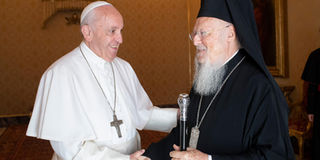Ecumenical relations between the Roman Catholic and Eastern Orthodox churches

Pope Francis and Ecumenical Patriarch Bartholomew of Constantinople meet privately at the Vatican. Photos / Net.
What you need to know:
- FYI. The Roman Catholics and Eastern Orthodox reject the Protestant doctrine of justification through faith alone, writes Msgr John Wynand Katende.
Recently, we joined the Catholic Church in celebrating 60 years of ecumenical journey with other Christian churches. Today, we briefly look into the inside story of the relations between the Catholic and Eastern Orthodox churches.
Roman Catholics and Eastern Orthodox were originally one church. Both claim the apostolic line of succession from Peter down through the popes and bishops. The Church, then, was led by five patriarchs in Rome, Constantinople, Alexandria, Antioch, and Jerusalem. Rome’s patriarch (or pope) held authority over the other four patriarchs. However, when Alexandria, Antioch, and Jerusalem fell to Muslim conquest in the 7th century, Constantinople and Rome remained the two main centres of Christianity.
The Eastern church (Constantinople) and the Western church (Rome) developed disagreements on some doctrinal issues. The Roman Catholic church has a worldwide hierarchy, with the pope in Rome as the supreme leader. Yet, the Patriarch of Constantinople is considered equal to all the other bishops in the Orthodox Church, but given the honorific title of ”primus inter pares” (first among equals).
Both the Roman Catholics and Eastern Orthodox reject the Protestant doctrine of justification through faith alone. They believe salvation is a process, beginning with baptism, and continues by cooperating with grace through faith, good works of mercy, prayer and receiving the sacraments of the church.
Roman Catholics believe the mission of the Holy Spirit proceeds from the Father together with Jesus the Son (“Filioque”), the Eastern Orthodox believe that it originates from God the Father alone. This controversy was the chief cause of mutual excommunication, ending in the 1054 Schism.
Eastern Orthodox and Roman Catholics believe that grace is the free and undeserved help that God gives us to respond to His call to become His adoptive children, partakers of the divine nature and of eternal life. A Christian can be restored to grace through confession of mortal sins to a priest and doing penance. The Eastern Orthodox, however, one can confess their sins to God before a “spiritual guide”, priest or authorised lay man or woman.

Religion fosters unity. Roman Catholics and Eastern Orthodox have some similarities.
Eastern Orthodox and Catholics address their priests as Father.
Following the Jewish Passover practice, Catholics use unleavened bread for Mass, whereas Eastern Orthodox, following Jesus’ resurrection, use leavened. Catholics keep the Eucharist and adore it, Orthodox do not.
Roman Catholic believe in Doctrinal development, as a result of interaction between faith and reason. For Eastern Orthodox, the early Church and the Bible must not be altered in any way; to avoid heresies and false doctrines.
The differences
Unlike Roman Catholics, Eastern Orthodox do not accept the concepts of purgatory and Stations of the Cross. Both use the crucifix . The Orthodox cross themselves from right to left, by placing the thumb and first two fingers together; signifying the doctrine of the Holy Trinity. Catholics cross themselves from left to right, using the entire palm, signifying movement from curse to blessings (Matthew 25:31-33).
Roman Catholics believe that Mary, the mother of Jesus, was conceived in her mother’s womb without original sin (Immaculate conception), and remained a sinless virgin. The Eastern Orthodox believe she was just like all other humans, but remained a holy virgin.
Roman Catholics and Eastern Orthodox use the Greek Old Testament scriptures (Septuagint), with 1 and 2 Maccabees, Tobit, Judith, Sirach, Wisdom, and Baruch. Yet, the Eastern Orthodox Bible has additional writings.
The Eastern Orthodox venerate icons, while Roman Catholics have statues and icons. Orthodox follow the Julian calendar while Catholics follow the Gregorian calendar.
Eastern Orthodox priests can marry before they are ordained, while in the Roman Catholic Church, priests do not marry. Both call their priests “Father”.
Reconciliation between the Catholic and Orthodox churches began with the historic meeting in 1964 between Ecumenical Patriarch Athenagoras and Pope Paul VI. Both churches collaborate in combating racism, religious intolerance, fundamentalism, poverty, divisions, climate change, among other issues.
“The division of Christians is a scandal because there is no true witness to the Gospel except in unity of the members of the body of Christ” says Pope Francis.
Did you know?
“The division of Christians is a scandal because there is no true witness to the Gospel except in unity of the members of the body of Christ” says Pope Francis.
Eastern Orthodox and Roman Catholics believe that grace is the free and undeserved help that God gives us to respond to His call to become His adoptive children, partakers of the divine nature and of eternal life. A Christian can be restored to grace through confession of mortal sins to a priest and doing penance.





